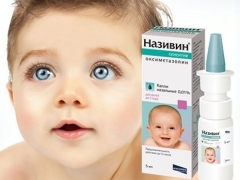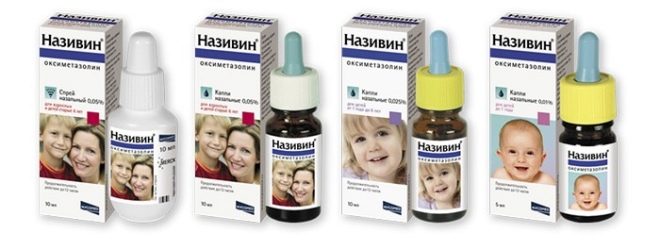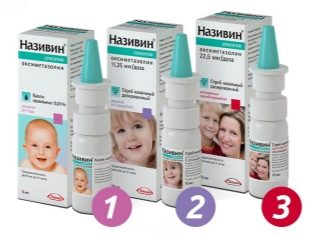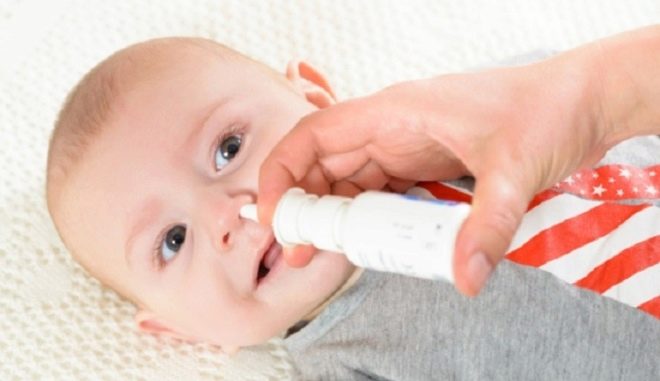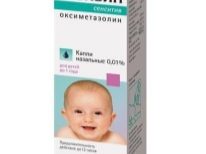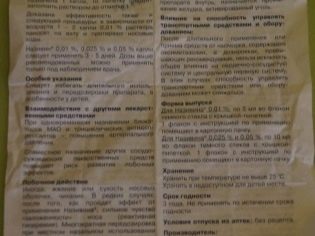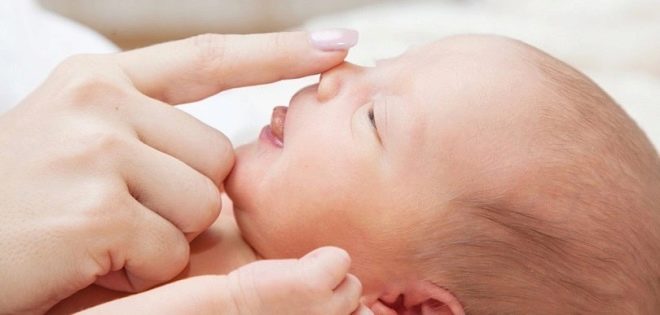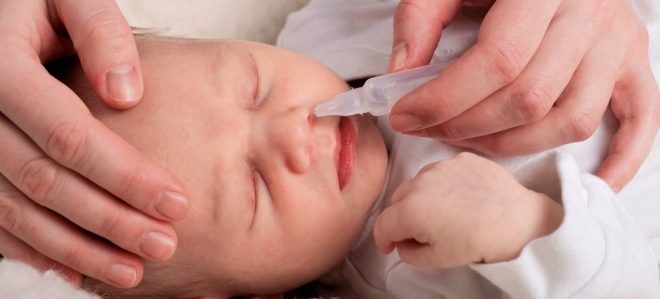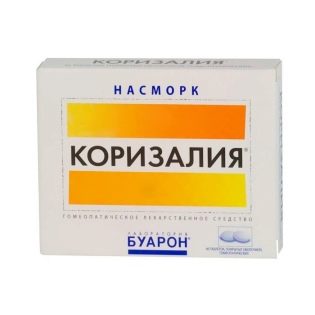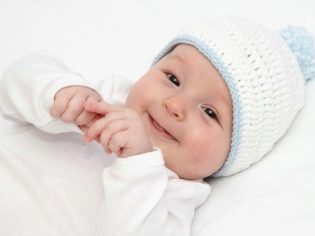"Nazivin Children's" for babies
A runny nose can be triggered by various factors, among which the most frequent are considered to be a viral infection, an allergic reaction, or bacteria. Such factors often affect children, so even mothers of infants face the need to treat rhinitis.
Babies under one year old do not have a cold to take food and sleep, which is why drugs are often chosen to eliminate it. The most demanded vasoconstrictor drugs, one of which is Nazivin. Is it possible to use it in the treatment of an infant, how does such a medicine work and in what dose is it given to babies with rhinitis?
Release form and composition
Nazivin is produced in liquid form and is a practically clear solution. He has a yellowish tint or no color. The main component of the drug is oxymetazoline hydrochloride. Depending on its concentration and packaging, there are such variants of Nazivin:
- 0.01% nasal drops (contain 100 μg of active compound in 1 milliliter).
- Nose drops with a concentration of 0.025%.
- Nasal drops containing 0.05% of the active ingredient.
- 0.05% nasal spray.
The drug in the form of drops is placed in glass bottles, which have a special cap-dropper. The volume of the drug with the lowest dosage (0.01%) is 5 ml, and the vials with 0.025% and 0.05% medication each contain 10 ml of solution. Spray packed in plastic bottles, equipped with a spray. There is 10 ml of solution in one bottle.
In addition to Nazivin, pharmacies also contain a drug called Nazivin SensitiveAvailable in drops (0.01%) and spray in two dosages. It also contains oxymetazoline as the most important ingredient, but excipients in its composition are different. While in normal Nazivine we see benzalkonium chloride, sodium hydroxide, sodium hydrogen phosphate, purified water, sodium dihydrogen phosphate and edetate disodium in droplets, but in Sensory drops, in addition to oxymetazoline and water, there is glycerol, citric acid and sodium citrate.
The composition of the spray ingredients Nazivin and Nazivin Sensitive is almost the same. It contains sodium citrate, glycerol, water and citric acid. But in the usual Nazivin, benzalkonium chloride is also present in the form of a spray, which is important to consider for mothers of allergic children.
Operating principle
Oxymetazoline in the composition of the effect on alpha-2 adrenergic receptors of blood vessels located in the mucous membrane of the nasal passages. This leads to a narrowing of the vessels, resulting in swelling of the nasopharynx is reduced, and the amount of discharge decreases. Thanks to the use of the medication, nose breathing is quickly restored. In addition, the drug affects both the middle ear cavity and the paranasal sinuses, which prevents the appearance of bacterial complications and helps in the treatment of inflammation in these areas.
When using the medication in the prescribed dosage, Nazivin acts only locally, is not absorbed into the blood, does not provoke redness and does not irritate. The therapeutic effect after hitting the nose begins to appear after a few minutes and lasts up to 12 hours.
Indications
Nazivin apply:
- With ARVI, if one of the symptoms is a runny nose.
- With vasomotor rhinitis.
- With allergic rhinitis.
The drug is also prescribed in combination with other drugs for otitis, sinusitis or eustachitis. In addition, the medication is prescribed before performing any diagnostic procedures in the nasal passages.
Do children under one year?
In infants, only Nazivin in the form of drops with a concentration of 0.01% is allowed. Also, in babies of the first year of life, Nazivin Sensitive can be used in drops, since the concentration of such a drug is also 0.01%. Other types of drug under the age of one year are not prescribed.
Contraindications
Nazivin can not be used if the child:
- There is hypersensitivity to any of the components of the solution.
- Revealed angle-closure glaucoma.
- Diagnosed with atrophic rhinitis.
If a small patient has diabetes, cardiovascular disease, or thyrotoxicosis, treatment with Nazivin requires caution.
Side effects
- Some babies after instillation of Nazivin appear unpleasant sensations in the nose, burning or dryness, as well as sneezing.
- When the drug stops the action, the occurrence of reactive hyperemia is possible, which is manifested by a feeling of nasal congestion.
- Occasionally, the use of the drug leads to nausea, headache, sleep disturbances, fatigue, or restless behavior.
- Over-long treatment with Nazivin causes addiction and can cause rhinitis, as well as mucosal atrophy.
Instructions for use for children under the year
Recall that in the treatment of infants used only drops Nazivin or Nazivin Sensitive with oxymetazoline content in a concentration of 0.01%. To accurately dispense these forms of medication, on a pipette attached to the cap of the bottle, there are marks in the drops. If the crumbs are assigned 1 drop, then the solution should be added to the “1” mark.
For babies up to one year, the drug can be administered in two ways:
- Drip directly into the spout.
- To drip on the cotton flagellum and wipe the nasal passage.
For newborn babies, a single dose of medication should not exceed 1 drop of solution in each nostril. A baby older than a month can be dripped either one drop at a time, or 2 drops at once, if the doctor recommended such a dosage.
The frequency of administration of Nazivin per day is 2-3 times, and the duration of treatment is usually 3-5 days.
Overdose
Excess doses in children can provoke tachycardia, vomiting, fever, constriction of the pupils, increased blood pressure and other symptoms. In severe cases, it is possible to suppress the work of the heart, pulmonary edema, arrhythmia, respiratory disorders and mental disorders. Having found an overdose, you should immediately wash the baby's stomach and give activated charcoal, and then seek medical help.
Interaction with other drugs
Nazivin, like other drugs from the group of vasoconstrictor agents, cannot be combined with antidepressants (tricyclic) and MAO blockers. Such medicines can not only be given to the patient together, but also there should be at least 10 days between their use. In addition, it is forbidden to drip Nazivin along with any other vasoconstrictor drugs, since this will increase the risk of side effects on the children's body.
Terms of sale
Any type of drug is sold in pharmacies without a prescription. The average price of a 0.01% bottle of Nazivin is 150 rubles, and Sensitiv drops cost about 170-180 rubles per bottle.
Storage conditions and shelf life
After the purchase, keep the house drops in a place where the medicine will not be exposed to high temperature (it should be no higher than +25 degrees) or high humidity. In addition, the drug must be safely hidden from children. The shelf life of both Nazivin and Sensitiv is 3 years.
Reviews
On the treatment of babies under a year old Nazivin there are quite a few positive reviews.In them, parents confirm the rapid therapeutic effect and ease of use of such a tool. According to them, the drops effectively eliminate swelling for a long period and facilitate the breathing of the little ones.
The drug is praised for the use in infants, long shelf life and affordable cost. The disadvantages are the risk of habituation and the appearance of side effects, for example, drying out the mucous membrane. In addition, for some children, the drug is ineffective, so it is replaced by another medication.
Analogs
Instead of Nazivin, other oxymetazoline preparations are usually used, for example, Nazol, Afrin, Vicks Active Sineks, Nesopin or Noksprey. However, most of them are released with a concentration of 0.05%, so they are prohibited for infants. For children up to one year, only drops like this can be replaced by Nazivin based on the same active compound as Sialor rino and Oxyphrine. Only they are represented by a dosage of 0.01% permitted for children of the first year of life.
A child younger than a year as an analogue of Nazivin, the doctor may recommend other medications that are needed for a cold:
- Nazol Baby. Such drops containing phenylephrine, constrict blood vessels in the nasal mucosa, thereby eliminating puffiness and redness. The drug is used at any age, but children under 6 years old should be prescribed with caution.
- Aqua Maris. Such drops are sea water and are approved for use from birth. With a cold, they help reduce inflammation, wash away bacteria or viruses, and also relieve puffiness. The drug is also used for prophylactic purposes, because such drops moisturize the mucous membrane well and stimulate the body's defenses.
- Derinat. This drug, available in drops and spray, contains sodium deoxyribonucleinate. Such a compound has an immunomodulatory effect, activating both humoral and cellular factors of immunity, due to which viruses, bacteria or fungi are destroyed more actively. The tool is required for SARS and influenza, as well as for adenoiditis, otitis or pollinosis. It can be dripped or injected into the nose of a child of any age.
- Salin. The basis of this spray is the physiological solution, so the drug is harmless to infants. To use it in children younger than a year, the bottle of Salina is turned over and the solution is applied as drops. The drug prevents overdrying of the nasal mucosa, reduces swelling and inflammation.
- Protargol. Such drops contain silver proteinatin with antibacterial action. The drug is in demand for the common cold provoked by pathogens. It can be dripped into the nose even for newborns, because silver from such a means is not absorbed, but acts only at the treatment site.
- Corisalia. This homeopathic remedy in pills can be given to a child of any age. Its components help to eliminate the inflammatory process in the nose, get rid of swelling, itching, sneezing and other symptoms of rhinitis.
How else to help your baby with a cold?
In addition to the use of vasoconstrictor drugs, in the treatment of rhinitis in infants it is recommended to consider the following nuances:
- Since babies do not know how to blow their nose, parents need to constantly remove excess mucus from the toddler's nasal passages. To do this, optimally apply a syringe with a soft spout or aspirator.
- To runny nose crumbs quickly passed, you need to monitor the microclimate in the room. If the baby breathes very warm and dry air, it can worsen the symptoms of the disease.
In addition to humidifying the air, you need to regularly clean the room from dust and give the little one to drink more.
- In children under one year, nasal rinsing is not used, because it is dangerous and may cause fluid to enter the auditory tube or the lungs. In addition, steam inhalations should not be given to such small children.
- You should not try to treat the babies runny nose with some folk remedies, because it is impossible to guess how a small child will react to popular recipes. You can not drip into the nose of the baby any broths, herbal infusions or juices.
- Do not bury mother’s milk in baby’s nosebecause it is a good environment for the development of microorganisms, which threatens with the addition of bacterial complications.
Dr. Komarovsky explains how to clear a child's nose from snot.
